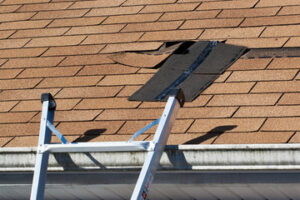One of the most common signs of a roof leak is a wet patch on the roof. You can use a flashlight to find these areas. In older leaks, you may notice wood rot or even dark mold growing at the leak’s site. You can also check the insulation batts on the rafter bays for wet spots. The cause of the leak may be obvious, such as missing shingles or exposed fasteners. If the roof is leaking around a vent pipe or dormer, the problem is likely the flashing in those areas. To inspect your roof efficiently, hire a professional roofer.

The leak itself may not be obvious. However, you can detect if water is trickling into the attic by looking for streaks of water on your ceiling or in the attic. To find the source of a roof leak, check out less-used parts of your home. Also, check if there have been previous leaks. If you discover streaks on the ceiling, you might leak to another part of the roof.
If you find a small hole in a shingle, you can cover it with sheet metal flashing. You may need to pry up some roofing nails to get to the damaged shingle. The sheet metal flashing must be installed below the next course of shingles above the leak. This way, water will shed over the sheet metal rather than pooling inside the home. But if the leak is deeper in the ceiling, you may have to remove the entire shingle before the sheet metal is installed.
Another way to spot a roof leak is to watch it during a rainstorm. In addition to listening for dripping sounds inside the attic, you should also check the area below the shingles for signs of dampness. Using a garden hose to simulate rain can be an effective method of identifying the leak by using one small section of the roof at a time. This way, you can focus on the specific area and get a better idea of the extent of the leak.
If you don’t have access to a professional roof repair company, you can make a temporary patch on your own with tar and roofing shingles. A temporary patch can be created using a putty knife and roofing tar. Just make sure to monitor the patch for leaks and call a roofing specialist as soon as you can afford it. If you’ve already tried making a temporary patch, then the damage is too extensive to repair by yourself.
There are several types of leaks that may occur on a roof. Some of these leaks are caused by condensation, which is when water vapor in the air cools below the dew point temperature. When this happens, liquid water forms on the roof surface and leaks through it. A leak on your roof can cause serious damage to the interior of your home. Your insurance company will probably cover the cost of the repair or replacement. But if you haven’t had the time to identify the cause of the leak, it may be worth calling a professional.
If a roof leak is causing you pain, you should take immediate action. The first sign of a roof leak is a small drip in the ceiling or attic. Once the water has entered the house, it will seek a place to escape from and continue to cause damage. In addition to the dripping sound, the drip will also damage the ceiling joints and light fixtures. Ultimately, the only way to stop the damage caused by a leak is to prevent the water from spreading further.
The next step in identifying a roof leak is to find the point of entry. Try to locate the original point of entry by examining the attic. Look for any visible damage and pour water. If the original hole is hidden, the leak could be in a place that you can’t see. You might also notice a hole in the outside of your roof has a slope. Water flowing down the slope of the roof could have also caused this damage.
Another source of a roof leak is a cracked or ripped neoprene pipe boot. A crack in this boot can allow water to enter and cause damage for years before the leak is discovered. Alternatively, you can slip a piece of metal flashing underneath the shingles and secure it with roof cement or caulk. If you cannot find the leak yourself, a roof leak repair professional can perform the repairs for you.
